RetroLisa
---------------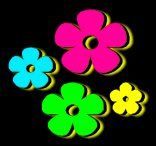 | Flower Power | |
|
___________________________________________________________________________________________________________
|
|
|
RetroLisa
| ___________________________________________________________________ | __ | _____________________________ | _______ | Origins
hippies
flower children
the counterculture
the love generation
Many young people rebelled against the social conformity of the 1950s by flocking to the counterculture lifestyle in the 1960s.
A decade earlier, members of the counterculture were known as beats, beatniks and the Beat Generation. In the 1930s and 1940s, nonconformists were called hipsters.
The term hippie was used by hipsters as far back as the 1930s to describe the young kids who emulated the hip lifestyle. The term entered the mainstream in 1965 when it was used by a newspaper columnist to refer to all members of the San Francisco counterculture. The term flower power was coined by beatnik poet Allen Ginsburg in 1965. The hippies themselves preferred the label freaks.
Hippies identified strongly with the Native American culture. They thought of themselves as white Indians.
In reality, only 10 to 15 percent of young people were real hippies. A larger number of teens and college students were considered weekend hippies or plastic hippies. These young people empathized with the counterculture, but only lived the hippie lifestyle when it was convenient.
Despite their size, these groups were hugely influential in shaping the ideologies of young people in the 1960s.
the counterculture lifestyle stressed
- freedom
- peace
- love and tolerance
- getting back to nature
- expanding your point of view
- the power of the group
From Beats To Hippies
Flower Power
| |


"A hippie is someone who dresses like Tarzan, has hair like Jane and smells like Cheetah."
--California governor Ronald Reagan
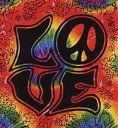
Visit my Celebrities page to see who led the counterculture movement
|
_________________________________________________
|
|
|
RetroLisa
| ___________________________________________________________________ | __ | _____________________________ | _______ | Lifestyles
creating a beautiful new world
Hippies had an idealistic view of the world. They strived to live in harmony with nature, to demonstrate tolerance and understanding towards their neighbors, and to embrace the mystical and magical aspects of the universe.
Hippies tried to remodel the world in their image. Flowers and bright colors were everywhere. Children were given names like Sunshine and Rainbow. People demonstrated against war and racism.
The peace symbol was designed in 1958 as the official logo of Britain's Campaign for Nuclear Disarmament. The lines inside the circle represent the semaphore letters N (nuclear) and D (disarmament). In the 1960s, the logo came to represent peace for everyone, and has become one of the most recognized symbols in the world.
Hippie Baby Names
What Was Accomplished In The 60s
--------by Abbie Hoffman
Wise Words
Hippie Quotes
Origin Of The Peace Symbol
do your own thing
Hippie fashion was whatever you wanted it to be. The important thing was to wear clothing that represented you. If the straight crowd gawked at you or looked away in shock, so much the better.
Hippies loved to wear clothing with ethnic designs. Wild Bohemian prints and Native American looks were especially popular. Tie-dyed fashions were also common. Girls wore long skirts, knitted shawls and granny glasses. Most hippie looks came straight from the racks of the local thrift store.
"Long, straight, curly, fuzzy, snaggy, shaggy, ratty, matty, oily, greasy, fleecy, shining, gleaming, streaming, flaxen, waxen...."
Gone were the days when you tried to tame your hair with Brylcream, hairspray, curlers and straighteners. Hair was allowed to go natural in the late 1960s.
Where The Hippies Get Their Clothes
don't trust anyone over 30
For most of the 20th century, young people were a source of anxiety for adults. This decade was no exception. In the past, however, youngsters usually respected their elders and accepted the fact that they would probably grow up to be just like them. This was not the case for hip young people in the late 1960s. They hated everything their parents stood for and vowed never to be like them.
Hippies distrusted and disrespected authority figures of all kinds. Mainstream society was the establishment....the police were pigs.
The generation gap was a term that gained popularity in the 1960s. During this decade, it got wider and wider.
Young people detested everything that was plastic or phony. They were encouraged to tell it like it is.
While the hippies saw themselves as being real, mainstream society saw them as being quite selfish and self-centered.
The Language Of The Hip
underground publications
Hip books, newspapers, magazines and comics were written by the counterculture, for the counterculture...
Psychadelic 60s Literature
Wannabe Hippies Reading List
| | 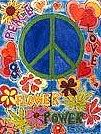
--

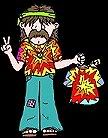
Let your freak flag fly!


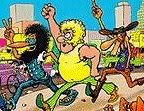

|
_________________________________________________
|
|
|
RetroLisa
| ___________________________________________________________________ | __ | _____________________________ | _______ | Places & Events
love-ins
Hippies celebrated their free lifestyle when they gathered by the hundreds for love-ins and be-ins.
In 1967, the first human be-in was held at Golden Gate Park in San Francisco. A much smaller event was held the same day at Griffith Park in Los Angeles. Later that year, gatherings were held at Griffith Park and Elysian Park in Los Angeles and Central Park in New York City. The term love-in was coined by Peter Bergman of the Firesign Theater comedy troupe while he was organizing the Elysian Park event.
Love-ins typically included free rock concerts, face painting, girls blowing bubbles....and plenty of drugs. They were advertised on underground radio stations and in counterculture publications.
Griffith Park and Elysian Park continued to host regular love-ins until at least 1971.
Robert Altman Summer of Love Photos
Pow-Wow Gathering Of The Tribes
Griffith Park Love-In
Griffith Park Photo Album
  
| |
"Bring bells, flutes, flags, drums & flowers; bring tangerines, food, incense, candles & joy"
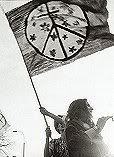
"Wow! Dig all the beautiful freaks!"
--San Francisco love-in participant |
San Francisco
The counterculture movement was very strong in San Francisco, especially near the intersection of Haight and Ashbury Streets. In 1965, this area became the center of the hippie universe when the Psychedelic Shop opened their doors to sell drug paraphernalia. Soon the neighborhood was home to hippies, rock bands and groups like the Diggers, who fed people in the park and opened Free Stores, where everything was free.
The 1967 Summer Of Love brought thousands of young people to the city, plus throngs of tourists who came just to gawk at the hippies. The original flower children resented this invasion of plastic hippies. They held a Death Of Hip parade, closed the Psychedelic Shop and began to move away.
About Haight-Ashbury
Haight-Ashbury Multimedia
The Digger Archives
Haight-Ashbury Timeline
San Francisco Locations

In San Francisco, the Straight Theater hosted the biggest names in psychedelic rock music, in addition to dance programs and avant-garde films.
At Monday Night Class (also known as the Astral Continental Congress) young people gathered weekly, smoked pot, listened to the teachings of Stephen Gaskin and talked about whatever was on their minds.
The Straight Theater
Stephen Gaskin
| |  |
everybody get together
Hippies favored the utopian concepts of communal living and sharing. This was combined with a desire to get back to nature. Most communes were located on farms, where the work was hard and the comforts were minimal.
The power of the group was very strong in the counterculture. A handful of charismatic men developed huge followings in the 1960s, similar to evangelists. These leaders persuaded their worshippers to travel with them, give up their worldly possessions and move to communes.
Ken Kesey's Merry Pranksters drove across America in a brightly-painted bus, drinking gallons of electric Kool-Aid and spreading the gospel of freedom and LSD. Members of the Hog Farm commune operated a free kitchen and provided other valuable services at the Woodstock music festival. Stephen Gaskin and his followers traveled across America as the Caravan before settling in Tennessee and forming The Farm commune in 1971.
The Farm Commune
Key-Z Productions
Intrepid Trips
Communal Living
Wavy Gravy & The Hog Farm Commune
Communal Living At The Farm
History Of The Farm
| |
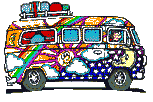
|
_________________________________________________
|
|
|
RetroLisa
| ___________________________________________________________________ | __ | _____________________________ | _______ | Drugs

tune in, turn on, drop out
By the mid 1960s, "LSD was no longer a drug but a whole climate of opinion"
--source unknown
LSD was first developed in 1938, and its hallucinogenic properties were discovered by accident in 1943. During the 1950s and early 1960s, the drug was legal and was readily available for clinical and experimental research. In the late 1950s, it became the drug of choice for artists, intellectuals and young people searching for a mind-altering experience. By 1971, it was estimated that five million Americans had taken it at least once. California made LSD illegal in 1966, and the rest of the country followed suit in 1968.
In California, Ken Kesey's Merry Pranksters drove from city to city conducting acid tests. Part freak-out, part rock concert, these events introduced many young people to the LSD experience. Participants received graduation posters and diplomas, as well as a new outlook on life.

This is Boris, the mascot for Zig Zag Rolling Papers. He became an icon for all those smokers who preferred to "roll their own," and I don't mean tobacco!
Erowid LSD Vault
Erowid Cannabis Vault
Drug Street Terms
Zig Zag Rolling Papers
LSD Facts & Myths
Acid Tests
Acid Test Posters
| |

"LSD is like Ban deodorant. Ban takes the worry out of being close....LSD takes the worry out of being."
--source unknown

|
_________________________________________________
|
|
|
